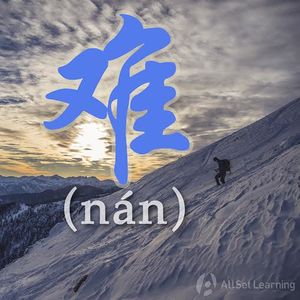Difference between revisions of "Expressing "difficult" with "nan""
| Line 48: | Line 48: | ||
<div class="liju"> | <div class="liju"> | ||
| + | * <em>难吃</em><span class="pinyin">Nánchī </span> <span class="trans">Not good/hard to eat</span> | ||
| + | * 你 做 的 菜 <em>很 难吃</em>。<span class="pinyin">Nǐ zuò de cài <em>hěn nánchī</em>. </span> <span class="trans">The dishes you cook taste bad. </span> | ||
| + | * <em>难喝</em><span class="pinyin">Nánhē</span> <span class="trans">Not good/hard to drink</span> | ||
| + | * 这里 的 咖啡 <em>很 难喝</em>。<span class="pinyin">Zhè lǐ de kāfēi <em>hěn nánhē</em>. </span> <span class="trans">The coffee here tastes bad. </span> | ||
* <em>难听</em><span class="pinyin">Nántīng</span> <span class="trans">Sounds bad (hard to listen to)</span> | * <em>难听</em><span class="pinyin">Nántīng</span> <span class="trans">Sounds bad (hard to listen to)</span> | ||
* 这 首 歌 <em>很 难听</em>。<span class="pinyin">Zhè shǒu gē <em>hěn nántīng</em>. </span> <span class="trans">This song is terrible (This song is hard to listen to). </span> | * 这 首 歌 <em>很 难听</em>。<span class="pinyin">Zhè shǒu gē <em>hěn nántīng</em>. </span> <span class="trans">This song is terrible (This song is hard to listen to). </span> | ||
| Line 54: | Line 58: | ||
* <em>难看</em><span class="pinyin">Nánkàn </span> <span class="trans">Looks bad/ugly (hard to look at)</span> | * <em>难看</em><span class="pinyin">Nánkàn </span> <span class="trans">Looks bad/ugly (hard to look at)</span> | ||
* 这 件 衣服 <em>很 难看</em>吗?<span class="pinyin">Zhè jiàn yīfu <em>hěn nánkàn</em> ma? </span> <span class="trans">Is this article of clothing ugly? </span> | * 这 件 衣服 <em>很 难看</em>吗?<span class="pinyin">Zhè jiàn yīfu <em>hěn nánkàn</em> ma? </span> <span class="trans">Is this article of clothing ugly? </span> | ||
| − | |||
| − | |||
| − | |||
| − | |||
</div> | </div> | ||
Revision as of 05:19, 23 November 2015
-
Level
-
Similar to
-
Used for
-
Keywords
Whenever something is "hard to do" (as in difficult) or "bad to do" (as in bad experience), the word 难 (nán) can be used.
Contents
难 with General Verbs
Structure
Just as 好 (hǎo) can be used to indicate that it's easy to do something, 难 (nán) can be attached to verbs, except sensitive words, to indicate that something is hard to do. The structure is:
Subj. + (很) 难 + Verb
Examples
- 难 懂Hard to understand.
- 这 句 话 很 难 懂。 This talk is hard to understand.
- 难 学 Hard to learn.
- 汉语 很 难 学。 Mandarin is hard to learn.
- 难 做 Hard to do.
- 中国菜 很 难 做。 Chinese are hard to make.
- 难 买 Hard to buy. (as in probably hard to find).
- 这 个 东西 现在 很 难 买。 This thing is really difficult to purchase now.
- 难 写 Difficult to write.
- 这 个 汉字 很 难 写。 This character is very difficult to write.
难 with Sense Verbs
Structure
难 (nán) can also be attached to "sense verbs" (e.g. look, taste, smell, etc.) to indicate that something is bad to do. The structure is:
Subj. + (很) 难 + [Sense Verb]
Examples
- 难吃 Not good/hard to eat
- 你 做 的 菜 很 难吃。 The dishes you cook taste bad.
- 难喝 Not good/hard to drink
- 这里 的 咖啡 很 难喝。 The coffee here tastes bad.
- 难听 Sounds bad (hard to listen to)
- 这 首 歌 很 难听。 This song is terrible (This song is hard to listen to).
- 难闻 Smells bad.
- 这 种 花 很 难闻。 This kind of flower smells bad.
- 难看 Looks bad/ugly (hard to look at)
- 这 件 衣服 很 难看吗? Is this article of clothing ugly?



